
Traditional Tibetan Medicine is a fascinating blend of ancient wisdom and holistic healing practices. Originating over 2,500 years ago, this system combines elements of Ayurveda, Chinese medicine, and indigenous Tibetan knowledge. It focuses on balancing the body's three humors: wind, bile, and phlegm. Practitioners use herbs, minerals, and animal products to create remedies tailored to individual needs. Diagnostic methods include pulse reading, urine analysis, and detailed patient interviews. Tibetan medicine emphasizes prevention, encouraging a balanced lifestyle and mental well-being. Despite its ancient roots, it remains relevant today, offering unique insights into health and wellness. Curious about its secrets? Let's dive into 25 intriguing facts about this ancient practice.
Key Takeaways:
- Traditional Tibetan Medicine (TTM) has a rich history dating back over 2,500 years, blending influences from Indian, Chinese, and Persian medical traditions. It emphasizes holistic balance of body, mind, and spirit, and uses unique diagnostic techniques like pulse diagnosis and urine analysis.
- TTM offers natural and non-invasive treatments such as herbal medicine, moxibustion, cupping therapy, acupuncture, and Tibetan massage. It also emphasizes the role of diet, lifestyle, and mental health, and continues to gain recognition and undergo scientific research in the modern world.
Origins of Traditional Tibetan Medicine
Traditional Tibetan Medicine (TTM) has a rich history that spans centuries. It combines elements of Indian, Chinese, and Persian medical traditions.
- TTM originated over 2,500 years ago in Tibet.
- It was influenced by Ayurveda from India, Chinese medicine, and Persian medical practices.
- The foundational text of TTM is the "Four Tantras" or "Gyud-Zhi."
Principles and Philosophy
TTM is based on a holistic approach, focusing on the balance of body, mind, and spirit.
- The core philosophy revolves around the balance of three humors: wind, bile, and phlegm.
- Health is achieved by maintaining harmony between these three humors.
- TTM also emphasizes the importance of diet, behavior, and environment in maintaining health.
Diagnostic Techniques
TTM uses unique methods to diagnose illnesses, combining observation, touch, and questioning.
- Pulse diagnosis is a crucial technique in TTM, where practitioners feel the pulse to determine imbalances.
- Urine analysis is another diagnostic method, examining color, smell, and sediment.
- Practitioners also use tongue diagnosis, observing its color, shape, and coating.
Treatment Methods
TTM offers a variety of treatments, many of which are natural and non-invasive.
- Herbal medicine is a cornerstone of TTM, using plants, minerals, and animal products.
- Moxibustion involves burning herbs on or near the skin to stimulate healing.
- Cupping therapy uses suction cups to improve blood flow and remove toxins.
- Acupuncture, similar to Chinese medicine, involves inserting needles at specific points on the body.
- Tibetan massage, known as Ku Nye, combines massage, acupressure, and oil therapy.
Role of Diet and Lifestyle
Diet and lifestyle are crucial in TTM for preventing and treating diseases.
- TTM recommends a diet that balances the three humors, tailored to individual needs.
- Seasonal changes in diet are advised to maintain balance throughout the year.
- Lifestyle recommendations include regular exercise, meditation, and proper sleep.
Spiritual and Mental Health
TTM places significant emphasis on the connection between mental and physical health.
- Meditation is a key practice in TTM for maintaining mental balance.
- Mantras and prayers are often used to promote healing and spiritual well-being.
- TTM practitioners believe that mental health issues can manifest as physical ailments.
Modern Applications and Research
TTM continues to evolve and adapt in the modern world, gaining recognition and undergoing scientific research.
- TTM is practiced worldwide, with clinics in countries like India, Nepal, and the United States.
- Research studies have shown the effectiveness of TTM in treating chronic diseases like arthritis and diabetes.
- The World Health Organization recognizes TTM as a traditional medical system.
Education and Training
Becoming a TTM practitioner requires extensive education and training.
- Training programs for TTM practitioners can last up to seven years.
- Students study subjects like anatomy, pharmacology, and diagnostic techniques, along with traditional texts.
The Essence of Traditional Tibetan Medicine
Traditional Tibetan Medicine (TTM) offers a rich tapestry of ancient wisdom and holistic practices. Rooted in the principles of balance and harmony, TTM emphasizes the interconnectedness of mind, body, and spirit. Its unique approach to diagnosis and treatment—using herbs, minerals, and lifestyle changes—has been practiced for centuries, providing a natural alternative to modern medicine.
Understanding TTM's core concepts, like the three humors (wind, bile, and phlegm), helps appreciate its depth. These humors must be balanced for optimal health. TTM also incorporates dietary guidelines, meditation, and yoga to promote overall well-being.
For those seeking a holistic approach to health, TTM offers valuable insights and practices. Its time-tested methods continue to benefit many, proving that ancient wisdom still holds relevance today. Embracing TTM can lead to a more balanced, harmonious life.
Frequently Asked Questions
Was this page helpful?
Our commitment to delivering trustworthy and engaging content is at the heart of what we do. Each fact on our site is contributed by real users like you, bringing a wealth of diverse insights and information. To ensure the highest standards of accuracy and reliability, our dedicated editors meticulously review each submission. This process guarantees that the facts we share are not only fascinating but also credible. Trust in our commitment to quality and authenticity as you explore and learn with us.
